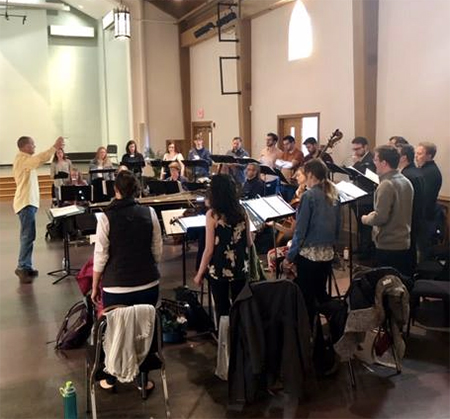by Timothy Robson

Festival director Dirk Garner conducted BWV: Cleveland’s Bach Choir, a select, 16-voice ensemble comprising BW alumni, professional singers, and three current voice students. The Festival Orchestra of excellent freelance musicians — three oboes, strings, and harpsichord — doubled the vocal lines. The resulting sound was robust, and although the singing and playing were clean, there was not much variation in dynamics.
Each of the five motets on the program — four of them for double chorus — had its own character, and as always with Bach’s works one could marvel at the genius of his unending contrapuntal variety. The opening Singet dem Herrn ein neues Lied, BWV 225 was energetic and agile. In the second movement, Choir II sings a chorale, and after each passage, Choir I interjects a litany-like single phrase. The third movement is a huge double fugue.
Der Geist hilft unser Schwachheit auf, BWV 226 is even more complex harmonically, with notable tone painting of the text about God’s intervention in our human frailty. The work ends with a four-part chorale. (In the otherwise top-notch program book, the text of the chorale and its translation were omitted.)
Komm, Jesu, komm, BWV 229 is considered to be a funeral motet, although no evidence exists of a particular service at which it was performed. It is notable for its second movement, in which the sopranos sing an independent, highly ornamented melody above a choral accompaniment.
The opening of Fürchte dich nicht, BWV 228 featured a beautiful lightness of texture that wasn’t apparent in most of the other performances. This was especially beneficial in the second part, with its intense chromaticism and gorgeous soprano line.
The four-part Lobet den Herrn, all Heiden, BWV 230, which closed the concert, contrasted with the other motets. After all of the despair and consequent chromatic music, this was a celebration of joy and praise, ending with a majestic fugue on the single word “Alleluia.”
The “Motets” part of “Suites and Motets” filled the bulk of the program, but that took nothing away from cellist René Schiffer’s performance of movements from Bach’s unaccompanied Cello Suites: the Allemande from Suite No. 6 in D, the Prelude from Suite No. 2 in d, and the Prelude from Suite No. 1 in G. As is the case with his many performances as Apollo’s Fire’s principal cellist, Schiffer’s sound was lucid, simultaneously filled with emotion and beautiful phrasing.
Published on ClevelandClassical.com April 15, 2019.
Click here for a printable copy of this article



